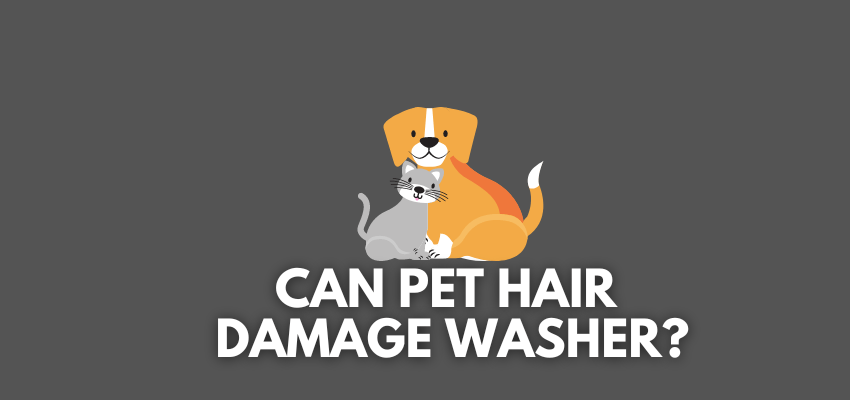Table of Contents
Last Updated on: 28th July 2023, 04:43 am
Pet hair can indeed cause damage to a washing machine if it accumulates and clogs essential components. The majority of new washing machines are able to handle pet hairs. However, the continuous occurrence may deter the protection unless the filter is regularly cleaned.
While washing machines are designed to handle a variety of fabrics and debris, excessive pet hair can lead to several issues that affect the machine’s performance and longevity.
I want to dig deeper into the reasons why pet hair can damage your washing machine so that you get some perspective on this.
Why Pet Hair Can Damage a Washing Machine
Let’s explore the reasons why pet hair can potentially damage a washing machine.
1. Clogging of Drainage System
One of the main concerns with pet hair in washing machines is its ability to clog the drainage system. As the washing machine drains water after each cycle, pet hair can become entangled with other debris and form clumps, blocking the drainage pipes and filters.
When the drainage system is clogged, water may not flow out efficiently, causing the machine to malfunction and leading to potential water leaks.
2. Damage to the Pump
When pet hair accumulates in the washing machine’s drainage system, it can also affect the pump. The pump is responsible for pumping water out of the machine during the drainage process.
If the pump becomes clogged with pet hair, it has to work harder to force the water out, putting extra strain on the motor and potentially leading to pump failure.
3. Damage to the Drum and Agitator
Excessive pet hair can become wrapped around the washing machine’s drum and agitator during the wash cycle.
This can cause the drum to become unbalanced, leading to excessive vibrations and potentially damaging the machine’s suspension system.
The agitator, which moves the clothes around, can also be affected, leading to reduced washing performance or even breakage.
4. Blockage in Filters
Washing machines have filters that trap lint, debris, and pet hair during the wash cycle. Over time, these filters can become clogged with pet hair, reducing their effectiveness.
When filters are clogged, it not only affects the machine’s cleaning ability but can also lead to potential damage as the machine struggles to operate with reduced water flow.
5. Impaired Heating Element Function
Some washing machines have heating elements that heat the water to the desired temperature for washing. When pet hair accumulates around the heating element, it can act as an insulator, preventing the element from functioning optimally.
This can result in longer washing times, higher energy consumption, and potential damage to the heating element itself.
6. Decreased Efficiency and Performance
Excessive pet hair in the washing machine can lead to decreased efficiency and performance. The machine may require more time and energy to complete a cycle, resulting in higher utility bills.
Additionally, clothes may not be cleaned as effectively due to reduced water flow and agitation, resulting in the need for re-washing and wasting water and detergent.
Preventing Damage and Maintenance
While pet hair can pose challenges to washing machines, there are several preventive measures and maintenance tips to avoid potential damage:
Pre-Washing and Lint Rolling
Pre-washing clothes to remove loose pet hair before loading them into the washing machine can significantly reduce the amount of hair that enters the machine.
Using a lint roller or adhesive tape to remove additional pet hair from clothes can also help prevent excessive hair buildup in the machine.
Regular Cleaning of Filters and Drains
Regularly clean the washing machine’s lint filter and drainage system to remove any accumulated pet hair and debris.
Check the pump area for clogs and clear any hair that might be causing blockages.
Using Washing Machine Pet Hair Catchers
Consider using washing machine pet hair catchers or lint traps to capture pet hair during the wash cycle, preventing it from entering the drainage system and filters.
Reducing Shedding
Regularly groom and brush your pets to reduce shedding. Vacuum areas where your pets frequent to minimize loose pet hair in your home and, consequently, in your washing machine.
Choosing the Right Cycle
When washing heavily soiled clothes with pet hair, opt for a longer and more robust cycle to ensure proper removal of hair and debris.
Also, make sure that you clean the washing machine filter before and after the wash.
Ready to Wash Clothes Full of Pet Hair?
By taking these preventive measures and performing regular maintenance, you can effectively protect your washing machine from potential damage caused by pet hair.
Additionally, it’s essential to follow the manufacturer’s guidelines and recommendations for your specific washing machine model to ensure its optimal performance and longevity.
Remember that a well-maintained washing machine will not only prevent damage but also provide better cleaning results for your clothes, keeping them fresh and free from pet hair.

